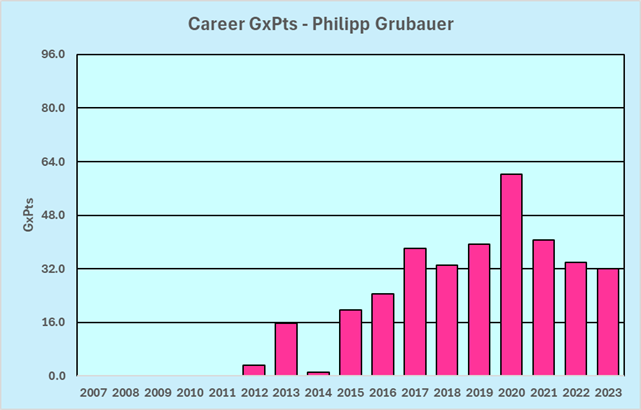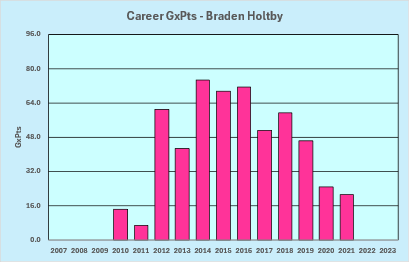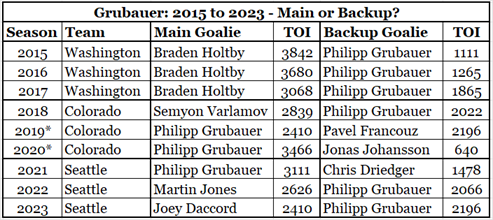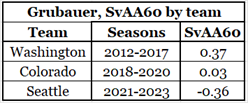My curiosity was piqued while browsing the hockey subreddit on Reddit. A post titled “What Happened to Philipp Grubauer?” caught my eye. The post said:
“Phillipp Grubauer had a record of 109-61-21 in 214 games with a goals-against average of 2.34 and a save percentage of .920 before 2021-22.
Phillipp Grubauer has a record of 54-75-12 in 150 games with a goals-against average of 3.09 and a save percentage of .890 for the Kraken in his career.”
Let’s use data to shine some light on Philipp Grubauer, allowing us to answer the poster’s question. The short answer will be in the Summary section, while the basis for the short answer will be the rest of this article.
Grubauer’s Press Clippings
In Grubauer’s last three seasons in Washington (2015-16 to 2017-18) the teams had 120, 118 and 105 points. In 2017-18, the Capitals won the Stanley Cup.
In his three seasons in Colorado (2018-19 to 2020-21) the teams had 90, 108 and 120 points. The last two point values are the pace the team was on for points in an 82-game schedule, as those were pandemic-shortened seasons.
From 2015-16 to 2020-21 Grubauer was a goalie on extremely successful teams.
He has not been as successful in Seattle: from 2021-22 to 2023-24 they had 60, 100 and 81 points, and this year they have 39 points through 44 games at the time of this writing.
One can imagine the thoughts of the poster. Here’s this goalie who had a six-year run on two extremely successful teams, even winning a Stanley Cup, and now he’s a backup on a non-playoff team in Seattle. What happened to him?
Clarifying the Press Clippings
If you stop and think for a minute, Grubauer’s press clipping numbers are not really that impressive. He had a six-year run on two successful teams and won 109 games: 18 wins a season. That is much less than the number of wins you would expect from a good goalie in a season.
The poster might have fallen for a quantitative fallacy, where a seemingly large number (109 wins) carries a lot of weight. It’s an easy fallacy to fall for, as 109 wins sounds a lot more impressive than 18 wins per season.
Advertisers hope their customers will fall for quantitative fallacies, except they do it in reverse. They’ll tell you that you can buy this here used truck for only $600 per month; then they’ll quietly mention you can pay it off in 84 months (or seven years, as seven is a nice small number). Your $600 per month used truck will cost you $50,400.
Stapled to the Bench’s View of Philipp Grubauer
The rating system Stapled to the Bench has for goalies is Goalie Expected Points (GxPts). It estimates the number of points an average scoring team would have with the goalie in nets for the amount of time the goalie played. It is based on a goalie’s time-on-ice, goals against and expected goals against. Below is Grubauer’s Career GxPts chart.

If you are thinking that Grubauer’s GxPts chart isn’t impressive, that the columns aren’t very high, you are right.
GxPts is not influenced by press clippings. Grubauer has had one very good season, 2020-21 with Colorado, where he was 4th in the league in GxPts. In no other year did he crack the top 20: his next three best seasons saw him ranked 24th, 25th and 29th.
Braden Holtby’s Career GxPts chart is that of a good goalie. You’ll notice that the bars on his chart are much higher than Grubauer’s bars in the 2015 to 2017 columns, when they were the two main goalies in Washington.

The poster might have been taken in by a false attribution fallacy. He thinks the reason those teams were successful was because of Grubauer’s play. The truth is that Grubauer’s statistics look good because he was playing on good teams.
Was Grubauer Ever His Team’s Main Goalie?
The available data (thanks, NaturalStatTrick) show that Grubauer was not normally his team’s main goalie. In his last three years in Washington, he was Braden Holtby’s backup.

His tenure in Colorado started with him as Semyon Varlamov’s backup, but he became the main goalie when Varlamov went to the New York Islanders. He did well in 2019-20 and had his best season in 2020-21, but the other goalies in Colorado’s system at the time were not especially good: none of them would have been in the top three goalies for Ottawa, a team which has not been blessed with reliable talent in the goalie department.
In Seattle, he began as the main goalie, but that seems to have been a decision made in the pre-season and stubbornly maintained throughout the season. Driedger’s SvAA60 was much better than Grubauer’s. Grubauer lost his main goalie job to Martin Jones in 2022-23, despite having a better SvAA60 than him (what goes around comes around). In 2023-24 he was still backup, and this time the data agreed with the team decision: Daccord had the better SvAA60.
The poster may have suffered from another classic fallacy, the cherry-picking fallacy. He ignored the fact that Grubauer played with other goalies, goalies who were usually better. The only times that Grubauer was the main goalie was when he played on teams where the other goalies were fringe-level NHL goalies.
Interesting Insider Information
In the comments to the post, a commenter said he had worked for the Coyote’s analytics department back in the day and “in 2018 when we made the Kuemper trade (in return for Wedgewood and Rieder to LA) we did a deep dive on a few guys to potentially pursue, including Grubauer.
Grubauer’s huge issue came down to the fact that Washington was able to heavily insulate his weaknesses. I don’t [sic] remember the specifics of where or what those were (and stopped watching hockey when the Coyotes left), but we determined that they did a phenomenal job preventing the shots that he was not good at saving, improving his overall performance.”
Now, I am well aware that just because somebody has entered something on the internet doesn’t mean that it’s God’s honest truth. Maybe the commenter worked in analytics for the Coyotes, maybe he tells a good story. Personally, I want the statement to be true because it shows the management of a hockey team using analytics data wisely. Also, I find it difficult to believe that a person who did analytics for a living would not remember the specifics of what would have been a very interesting analysis.
The data that Stapled to the Bench has, which is far less detailed than what a professional hockey team would have, can be interpreted to support the commenter’s statement that Washington was able to insulate Grubauer. His SvAA6o, which is his saves above average per 60 minutes, was very good in Washington, average in Colorado and poor in Seattle.

His save percentages in his two career phases also support the commenter’s statement. In his pre-Kraken phase, he had a .920 save percentage; in his Kraken phase, he had a .890 save percentage. If Washingt0n knew how to prevent shots Grubauer was not good at handling, and Seattle didn’t know this, the data would look like it does: lower SvAA60 and lower save percentage in Seattle.
The decrease in SvAA60 and save percentage could also have been caused by age and/or injury, so the data isn’t proof positive.
Could the Drop in SvAA60 be Related to the Teams Grubauer Played For?
No, it couldn’t. A goalie is entirely responsible for his SvAA60: it is a great indicator of a goalie’s level of play.
A team is “responsible” for the expected goals a goalie faces. On a good team, a goalie might face shots that would result in 100 goals against. On a bad team, a goalie might face shots that would results in 140 goals against.
The better goalies give up fewer goals than expected, regardless the quality of the team in front of them. A good goalie on a good team might give up only 90 goals, while a good goalie on a bad team might give up 126 goals against. In both cases these hypothetical goalies gave up 10% fewer goals than expected.
But … Grubauer Won a Stanley Cup
Not to rain on Philipp’s Stanley Cup parade, but he didn’t win the Stanley Cup in 2017-18. He played on a team that won the Stanley Cup.
Braden Holtby won the Stanley Cup. In that Stanley Cup run, Holtby played 1,386 minutes while Grubauer played 105 minutes. Holtby’s goals-against average was 2.16, Grubauer’s was a disappointing 4.55.
Grubauer started in nets in the first round, as he had been hot at the end of the regular season. He lost the first game 4-3 in OT. He started game two, was pulled and was effectively stapled to the bench (a phrase used on purpose) for the rest of the playoffs.
Thinking that Grubauer was a key reason for Washington’s Stanley Cup championship is another instance of the false attribution fallacy. Being a player on a team that won the Stanley Cup is not the same as a player being a significant factor in a team winning a Stanley Cup. Especially so when you don’t get a second of ice time after game two of the first round.
Summary
In two pandemic-shortened seasons, while playing on very good teams in Colorado that had no other good goalies available (with apologies to Francouz and Johansson), Grubauer had good traditional numbers. His record was 48-21-5 and his goals-against average was 2.63.
Both of those traditional statistics can be heavily influenced by the quality of the team in front of the goalie. Any adequate goalie would have put up good traditional numbers on those Colorado teams.
The poster’s question was “What happened to Philipp Grubauer?” The answer is: nothing happened to him. He is a backup goalie, and save for one good season, has always been a backup goalie.
Related Articles
